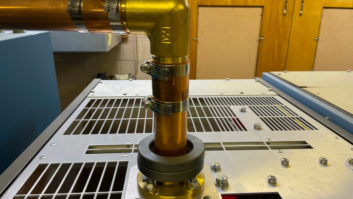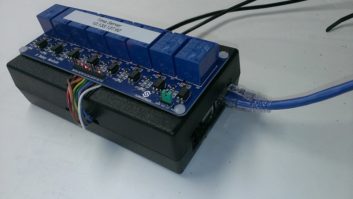ATLANTA — When the FCC approved Method of Moments as a valid tool to verify AM directional performance, I was immediately interested in employing the approach at CBS Radio’s WAOK(AM) 1380 in Atlanta. However, because WAOK had a mix of tower types, and by virtue of their height, we had to wait just a bit longer to employ MoM.

Kintronic VSU-1 is at work in the field at the WAOK(AM) transmission site.
I had heard that Kintronic Labs was working on a voltage sampling device specifically for stations that could not employ sample loops.
WAOK is a 5 kW NDA-Day/4.2 kW DA at night. The night antenna system consists of two self-supporting towers and two uniform cross-section towers, each 360 feet tall.
In December of 2010, I was contacted by Tom King at Kintronic Labs. They had just finished developing the VSU-1 voltage sampling device. I was interested in testing these devices on WAOK.
A few weeks later the VSU-1s arrived at our facility. The initial inspection of the units revealed that installation would be fairly easy. Each VSU has an N connector, to attach to the existing antenna monitor. There is also a bowl insulator and threaded stud to attach to the tower base. This connection is routed through a J Plug, so the VSU-1 can be installed and then connected to the antenna when ready. The J Plug is also handy during the testing phase. A grounding point is also provided.
Installation
Each VSU was attached to the tower using copper tubing. The existing sample lines were disconnected from the old loops and attached to the antenna monitor.
Physically, the VSU can be installed in a number of ways. Each VSU has four “ears” that enable the user to select the best method for installation. In our case, two of the VSUs are installed using galvanized fence posts. At the other two towers we elected to install the units on the sides of existing equipment at the tower base.
Each time I connected a VSU-1 to a tower, I checked the parameters of our antenna system. In three of the installations, the VSU-1 had little or no effect on the antenna system. On the fourth tower, we did detect a slight change in the tower parameters. This was attributed to numerous items across that tower base. We were able to “wash” this change out in the day and night LTU.

The WAOK array.
Consulting engineer Don Crain came in and did extensive measurements of the WAOK antenna system. This included verifying sample line length, transmission line length and the self-impedance of each tower.
Armed with this information, Don established the theoretical MoM parameters we would need to achieve the pattern. The night phasor was adjusted to these theoretical numbers. The next day, we went to the “old” monitor points toverify that the night pattern was correct. To my amazement, all of the points were in tolerance. We then ran the required set of reference measurements for the array. We obtained a license for the MoM operation in late spring of 2011.
These VSU-1 units survived a stormy spring and summer here in Atlanta. In late April, our Tower 3 was apparently struck by lightning. The top beacon was heavily damaged, including vaporized wiring, burned sockets etc. The VSU-1 connected to the base survived and to this day is providing stable samples of the tower. A peek inside the VSU-1 revealed no damage from this strike.
The VSU-1 Voltage Sampler is designed for easy installation and appears to handle “real-world” conditions with ease. For stations using tall towers or other nonstandard antenna configurations, the VSU-1 offers a way to move forward with MoM, and take advantage of the significantly easier monitoring of directional performance.
The author is market chief engineer with CBS Radio-Atlanta.
For information, contact Tom King at Kintronic Laboratories in Tennessee at (423) 878-3141 or visit www.kintronic.com.






